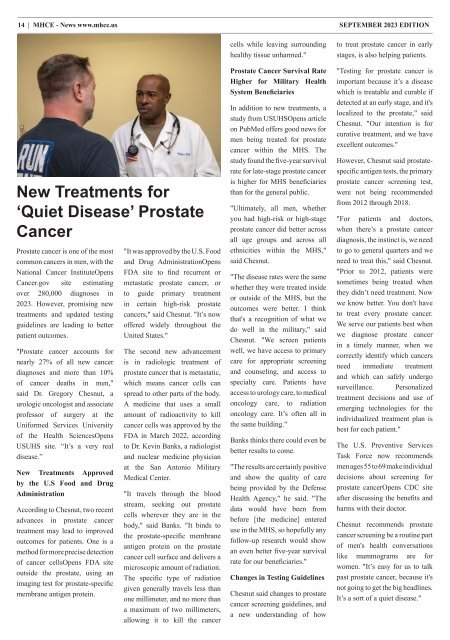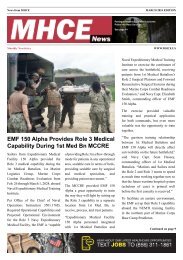Create successful ePaper yourself
Turn your PDF publications into a flip-book with our unique Google optimized e-Paper software.
14 | <strong>MHCE</strong> - News www.mhce.us SEPTEMBER <strong>2023</strong> EDITION<br />
New Treatments for<br />
‘Quiet Disease’ Prostate<br />
Cancer<br />
Prostate cancer is one of the most<br />
common cancers in men, with the<br />
National Cancer InstituteOpens<br />
Cancer.gov site estimating<br />
over 280,000 diagnoses in<br />
<strong>2023</strong>. However, promising new<br />
treatments and updated testing<br />
guidelines are leading to better<br />
patient outcomes.<br />
"Prostate cancer accounts for<br />
nearly 27% of all new cancer<br />
diagnoses and more than 10%<br />
of cancer deaths in men,"<br />
said Dr. Gregory Chesnut, a<br />
urologic oncologist and associate<br />
professor of surgery at the<br />
Uniformed Services University<br />
of the Health SciencesOpens<br />
USUHS site. “It’s a very real<br />
disease.”<br />
New Treatments Approved<br />
by the U.S Food and Drug<br />
Administration<br />
According to Chesnut, two recent<br />
advances in prostate cancer<br />
treatment may lead to improved<br />
outcomes for patients. One is a<br />
method for more precise detection<br />
of cancer cellsOpens FDA site<br />
outside the prostate, using an<br />
imaging test for prostate-specific<br />
membrane antigen protein.<br />
"It was approved by the U.S. Food<br />
and Drug AdministrationOpens<br />
FDA site to find recurrent or<br />
metastatic prostate cancer, or<br />
to guide primary treatment<br />
in certain high-risk prostate<br />
cancers," said Chesnut. "It’s now<br />
offered widely throughout the<br />
United States."<br />
The second new advancement<br />
is in radiologic treatment of<br />
prostate cancer that is metastatic,<br />
which means cancer cells can<br />
spread to other parts of the body.<br />
A medicine that uses a small<br />
amount of radioactivity to kill<br />
cancer cells was approved by the<br />
FDA in March 2022, according<br />
to Dr. Kevin Banks, a radiologist<br />
and nuclear medicine physician<br />
at the San Antonio Military<br />
Medical Center.<br />
"It travels through the blood<br />
stream, seeking out prostate<br />
cells wherever they are in the<br />
body," said Banks. "It binds to<br />
the prostate-specific membrane<br />
antigen protein on the prostate<br />
cancer cell surface and delivers a<br />
microscopic amount of radiation.<br />
The specific type of radiation<br />
given generally travels less than<br />
one millimeter, and no more than<br />
a maximum of two millimeters,<br />
allowing it to kill the cancer<br />
cells while leaving surrounding<br />
healthy tissue unharmed."<br />
Prostate Cancer Survival Rate<br />
Higher for Military Health<br />
System Beneficiaries<br />
In addition to new treatments, a<br />
study from USUHSOpens article<br />
on PubMed offers good news for<br />
men being treated for prostate<br />
cancer within the MHS. The<br />
study found the five-year survival<br />
rate for late-stage prostate cancer<br />
is higher for MHS beneficiaries<br />
than for the general public.<br />
"Ultimately, all men, whether<br />
you had high-risk or high-stage<br />
prostate cancer did better across<br />
all age groups and across all<br />
ethnicities within the MHS,"<br />
said Chesnut.<br />
"The disease rates were the same<br />
whether they were treated inside<br />
or outside of the MHS, but the<br />
outcomes were better. I think<br />
that's a recognition of what we<br />
do well in the military," said<br />
Chesnut. "We screen patients<br />
well, we have access to primary<br />
care for appropriate screening<br />
and counseling, and access to<br />
specialty care. Patients have<br />
access to urology care, to medical<br />
oncology care, to radiation<br />
oncology care. It’s often all in<br />
the same building."<br />
Banks thinks there could even be<br />
better results to come.<br />
"The results are certainly positive<br />
and show the quality of care<br />
being provided by the Defense<br />
Health Agency," he said. "The<br />
data would have been from<br />
before [the medicine] entered<br />
use in the MHS, so hopefully any<br />
follow-up research would show<br />
an even better five-year survival<br />
rate for our beneficiaries."<br />
Changes in Testing Guidelines<br />
Chesnut said changes to prostate<br />
cancer screening guidelines, and<br />
a new understanding of how<br />
to treat prostate cancer in early<br />
stages, is also helping patients.<br />
"Testing for prostate cancer is<br />
important because it’s a disease<br />
which is treatable and curable if<br />
detected at an early stage, and it's<br />
localized to the prostate," said<br />
Chesnut. "Our intention is for<br />
curative treatment, and we have<br />
excellent outcomes."<br />
However, Chesnut said prostatespecific<br />
antigen tests, the primary<br />
prostate cancer screening test,<br />
were not being recommended<br />
from 2012 through 2018.<br />
"For patients and doctors,<br />
when there’s a prostate cancer<br />
diagnosis, the instinct is, we need<br />
to go to general quarters and we<br />
need to treat this," said Chesnut.<br />
"Prior to 2012, patients were<br />
sometimes being treated when<br />
they didn’t need treatment. Now<br />
we know better. You don't have<br />
to treat every prostate cancer.<br />
We serve our patients best when<br />
we diagnose prostate cancer<br />
in a timely manner, when we<br />
correctly identify which cancers<br />
need immediate treatment<br />
and which can safely undergo<br />
surveillance. Personalized<br />
treatment decisions and use of<br />
emerging technologies for the<br />
individualized treatment plan is<br />
best for each patient."<br />
The U.S. Preventive Services<br />
Task Force now recommends<br />
men ages 55 to 69 make individual<br />
decisions about screening for<br />
prostate cancerOpens CDC site<br />
after discussing the benefits and<br />
harms with their doctor.<br />
Chesnut recommends prostate<br />
cancer screening be a routine part<br />
of men's health conversations<br />
like mammograms are for<br />
women. "It’s easy for us to talk<br />
past prostate cancer, because it's<br />
not going to get the big headlines.<br />
It’s a sort of a quiet disease."


















